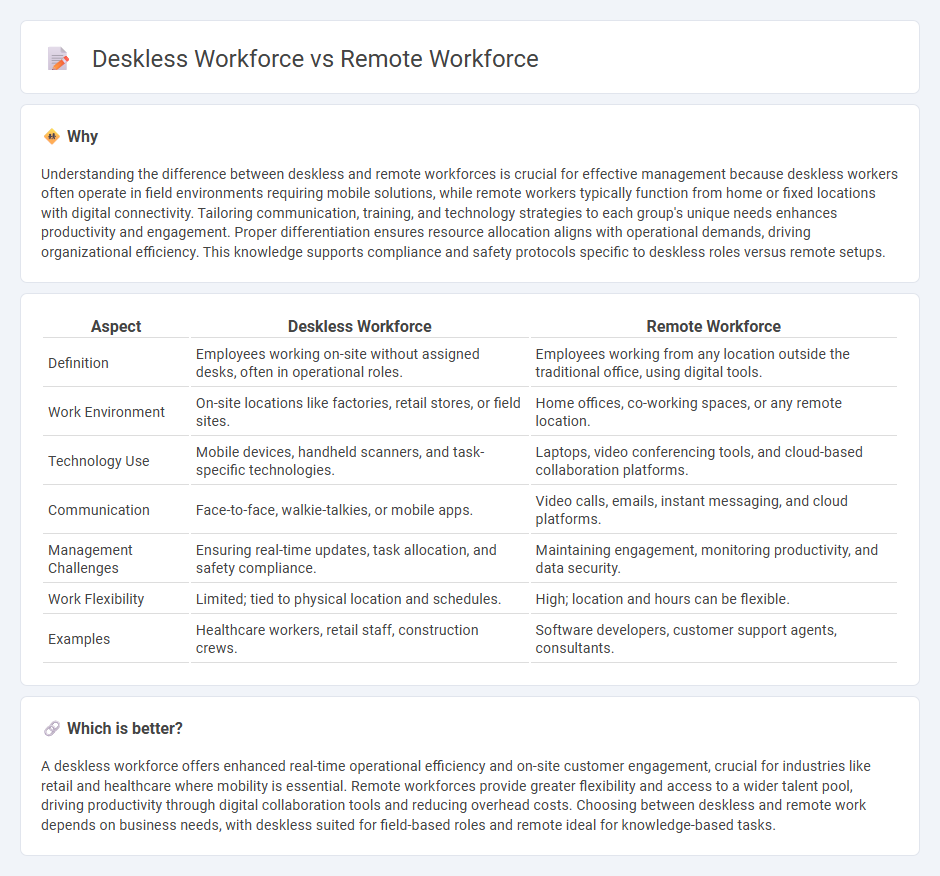
The deskless workforce, comprising employees without fixed office desks, operates primarily in dynamic environments such as retail, healthcare, and manufacturing, where mobility and real-time access to information are critical. In contrast, the remote workforce functions from varied locations, leveraging digital communication tools to maintain productivity and collaboration from home or co-working spaces. Explore more insights on effectively managing deskless and remote teams for optimized business performance.
Why it is important
Understanding the difference between deskless and remote workforces is crucial for effective management because deskless workers often operate in field environments requiring mobile solutions, while remote workers typically function from home or fixed locations with digital connectivity. Tailoring communication, training, and technology strategies to each group's unique needs enhances productivity and engagement. Proper differentiation ensures resource allocation aligns with operational demands, driving organizational efficiency. This knowledge supports compliance and safety protocols specific to deskless roles versus remote setups.
Comparison Table
| Aspect | Deskless Workforce | Remote Workforce |
|---|---|---|
| Definition | Employees working on-site without assigned desks, often in operational roles. | Employees working from any location outside the traditional office, using digital tools. |
| Work Environment | On-site locations like factories, retail stores, or field sites. | Home offices, co-working spaces, or any remote location. |
| Technology Use | Mobile devices, handheld scanners, and task-specific technologies. | Laptops, video conferencing tools, and cloud-based collaboration platforms. |
| Communication | Face-to-face, walkie-talkies, or mobile apps. | Video calls, emails, instant messaging, and cloud platforms. |
| Management Challenges | Ensuring real-time updates, task allocation, and safety compliance. | Maintaining engagement, monitoring productivity, and data security. |
| Work Flexibility | Limited; tied to physical location and schedules. | High; location and hours can be flexible. |
| Examples | Healthcare workers, retail staff, construction crews. | Software developers, customer support agents, consultants. |
Which is better?
A deskless workforce offers enhanced real-time operational efficiency and on-site customer engagement, crucial for industries like retail and healthcare where mobility is essential. Remote workforces provide greater flexibility and access to a wider talent pool, driving productivity through digital collaboration tools and reducing overhead costs. Choosing between deskless and remote work depends on business needs, with deskless suited for field-based roles and remote ideal for knowledge-based tasks.
Connection
The deskless workforce and remote workforce are connected through their shared reliance on mobile technology and cloud-based tools that enable communication, task management, and real-time collaboration outside traditional office settings. Both workforce types require management strategies focused on flexibility, digital engagement, and productivity monitoring to ensure operational efficiency. Effective integration of these approaches drives improved employee experience and business outcomes in industries like retail, healthcare, and field services.
Key Terms
Communication Tools
Remote workforce relies heavily on digital communication platforms such as Zoom, Slack, and Microsoft Teams to maintain seamless collaboration and information flow across dispersed locations. Deskless workforce benefits from mobile-first communication tools like WhatsApp, frontline worker apps, and SMS that enable real-time updates and task management in dynamic, on-the-go environments. Explore the latest innovations in communication tools tailored to optimize productivity for both remote and deskless workforces.
Autonomy
The remote workforce enjoys high autonomy, leveraging digital tools to manage tasks independently from any location, which enhances flexibility and productivity. In contrast, the deskless workforce operates on-site or in dynamic environments with limited autonomy due to the necessity of physical presence and coordination with teams. Discover how autonomy shapes the effectiveness and satisfaction of these distinct workforce models.
Mobility
Remote workforce relies heavily on digital tools and mobile connectivity to perform tasks from any location, emphasizing flexible work environments. Deskless workforce, prevalent in sectors like healthcare and retail, demands real-time access to mobile devices for operational efficiency and frontline communication. Explore how mobility strategies optimize productivity in both remote and deskless work models.
Source and External Links
Remote Workforce: Why It Matters and How To Manage One - Nextiva - A remote workforce consists of employees who work from home or another off-site location instead of commuting to a central office, leveraging technology for collaboration and productivity.
What is a remote workforce? - A remote workforce is a team not tied to a central location, with members free to work from anywhere as long as they have the necessary tools, and can include both employees and contractors.
What is a Remote Workforce? - Citrix.com - A remote workforce performs essential job responsibilities outside traditional office spaces, offering businesses benefits like increased productivity, cost savings, and better talent retention.
 dowidth.com
dowidth.com